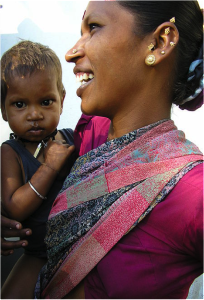
The First 1,000 Days
Many pregnant women in developing countries are malnourished and anemic. In India, for example, 70% of pregnant women are anemic, and 48% of children are stunted by age 2; the numbers are nearly as high in some subSaharan African countries. Maternal malnourishment often leads to low birth-weight babies, higher risk of maternal death at delivery, and stunting of young children. Malnourished children are much more susceptible to infectious disease. Now, new research shows that the consequences of maternal malnourishment are even greater and extend to the lifelong wellness of the child, because in a malnourished womb, epigenetic signals often turn on or off certain genes in the baby. The result is that such children are born with more fat cells and a life-long predisposition to obesity, diabetes, and heart disease.
 Disrupting this cycle by providing pregnant mothers with advanced nutritional supplements or full nourishment foods is one obvious response. The field trial will do exactly that, as well as experiment with ways to deliver the nutrition, and carefully document the outcomes.
Disrupting this cycle by providing pregnant mothers with advanced nutritional supplements or full nourishment foods is one obvious response. The field trial will do exactly that, as well as experiment with ways to deliver the nutrition, and carefully document the outcomes.
But nutrition is not the only lack in the current healthcare paradigm for maternal/child care. To be effective, nutrition must be part of a more integrated maternal care service delivery model, such as that proposed by The 1000 Days Initiative.
The traditional approach to maternal/infant care in developing countries puts doctors and formal health institutions at the center of the effort. But in places like rural India and Africa, there are simply not enough doctors and clinics to provide care through traditional models, and even fewer doctors are willing to work in rural communities. Moreover, the traditional model is far too expensive. The 1000 Days Initiative intends to demonstrate a radically different service approach.
Focus on wellness. Sick and emergency care are far more expensive than well care. So a key to the 1000 Days approach is an integrated service delivery package of preventive interventions (safe drinking water, advanced full range nutritional supplements, vaccinations) as well as careful monitoring at the woman’s home, with traditional medical care as the backup, when needed. The importance of addressing malnutrition is clear, but frequent enteric infections from unsafe drinking water can negate the effectiveness of both supplements and vaccinations—the whole wellness package is needed. And monitoring at home is virtually the only way to ensure compliance and catch danger signal early.
Focus on creating demand via successful babies. Higher capacity in women and their babies must be the goal, not just preventing death. Evidence that the wellness approach creates babies with the capacity for success in life is far more likely to create demand for it. Nutrition interventions for mother and child, and breast feeding, are critical to this.
Putting information-empowered community healthworkers at the center of the care model. Enabled and guided by modern tablet-based mHealth tools, they will provide at least monthly checkups and education in the patient’s home, supported by a local wellness or birthing center, and backed-up by visiting doctor/nurse teams on a quarterly basis and by phone in case of emergencies. The system will identify the few who need acute care (and reduce the overall disease burden).
Exploring public-private partnerships. Many governments want to improve maternal care and encourage institutional deliveries, but lack the ability to monitor pregnancies in local communities. The 1000 Days Initiative proposes that private entities or NGOs partner with government to provide a more integrated service model.
Real-time (byproduct) data collection and analysis. A modern, mobile ICT system underpins the enterprise. This means unprecedented capability for the health workers, and the ability to monitor patients, their health issues and compliance, worker performance, effectiveness of engagement strategies, etc., and hence to manage on a daily and weekly basis so as to retrain or replace lagging performers, while identifying and directing special attention to at-risk patients.
Radically different economics. Locally-employed healthworkers are inexpensive; specialist doctors are employed sparingly. Highly scalable ICT is central. That means the 1000 Days Initiative can potentially raise outcomes significantly while lowering the cost of service (compared to traditional models) to such an extent that many rural households could pay for the service, creating a sustainable model (or, alternatively, an affordable public sector model).